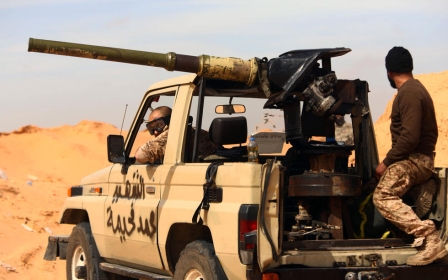IS seizes Libya airbase after Misrata forces pull out

TRIPOLI - Islamic State (IS) militants in Libya have taken control of an airbase on the outskirts of Sirte after forces fighting the group since February withdrew from positions, saying they lacked munitions and personnel.
Brigade 166, a unit from the city of Misrata loyal to the Tripoli-based government, which has been battling against IS since it took over government buildings and a radio station in Muammar Gaddafi’s hometown of Sirte, withdrew from the airbase and a camp to the east of the town late on Thursday night.
“The deputy commander of Brigade 166 Abdulghada Abushaalla said they withdrew from the airbase and other positions because they needed more soldiers, weapons and ammunition,” the head of Tripoli’s foreign media department, Jamal Zubia, told Middle East Eye. “They are waiting for more support from other brigades.”
The brigade has withdrawn to the al-Khalej power station 30 kilometres west of the town, where, earlier this week, a tanker was bombed by the Libyan Air Force operating under the internationally recognised government now based in eastern Libya, claiming it was carrying fighters and weapons to Sirte.
Zubia said Brigade 166 was regrouping, and, once more support arrived, would prepare to retake its lost positions.
The Gardabiya Airbase - said to be one of the largest in Libya - has not been in regular use for some time, but its infrastructure is understood to be functional. IS also claimed, on Friday, to have gained more territory and taken control of water tanks to the east of Sirte. Part of the Man Made River project, these supply water to the surrounding areas.
The takeover of the airbase is the latest IS advance after it expanded into the east of the town earlier this week, seizing a barracks occupied by Brigade 136 - a “silent” tribe-based armed group not fighting with any side but loosely affiliated to Libya’s eastern-based government. Its members deserted the camp after it was surrounded by IS militants, according to a local resident.
IS seized several T55 tanks from the camp and drove them, flying the black flag, to a roundabout on Sirte’s outskirts through which Libya’s main coastal highway runs, he said.
The local resident added that the growing IS power in the town had become evident during the last week by the appearance of new checkpoints manned by balaclava-clad militants, in areas previously controlled by Misrata’s Brigade 166.
Although some members of the brigade remain stationed at the al-Khalej power plant, other fighters have withdrawn to Misrata, sparking fears for the stability of an active frontline near the power station and prompting one of Brigade 166’s two field hospitals in Sirte to close, a field medic said.
“Misrata forces are the only ones fighting ISIS but they are also fighting in the south at Sebha and in the west at al-Wattiyah, so the situation is very bad,” he said. “They don’t have enough weapons or people and they don’t want more fighting, more war, or any more deaths.”
He estimated that, in the last two months of fighting in Sirte, 40 people had been killed and at least 70 people injured, all from the city of Misrata.
Civilians living in towns to the east of Sirte have been alarmed by IS expansion in the town, which, they fear, will see their already isolated locations cut off from all outside support.
“We now have ISIS on both sides of us - 70 kilometres to the east in Sirte and just 50 kilometres to the west in Nufaliya - and the people of our town are in great danger,” said a doctor from Harawa, speaking on the condition of anonymity. “We were attacked twice, in March and then again in May, and we defended our town but no one has come to help us. There has been no government or military support.”
The isolated position of the town has left it vulnerable to further attack, he said. After local people - mainly young volunteers - had fought back against IS, killing nine of the militants and commandeering four armed vehicles, townspeople feared a revenge attack was imminent.
“We have made almost daily requests for two months for help but there have been few responses and promises have not been honoured. We have asked both governments but our area is controlled by Tripoli, so we turn more to them,” the doctor said. “It promised it would do something this week but now the week has ended and again they did nothing.”
Now that IS controlled more areas in Sirte, local people were sure they would come to Harawa, he said. “The situation is now even more dangerous for us. There are very few soldiers here but if we have to, ordinary civilians will fight to defend our homes, our families and our town,” the doctor explained. “We have no choice because we have nowhere else to go.”
The apparent focus of IS on the oil-rich Gulf of Sirte has sparked fears that it has its sights set on taking complete control of some of the country’s main oil fields and facilities, which could provide a lucrative source of income for further expansion.
Middle East Eye propose une couverture et une analyse indépendantes et incomparables du Moyen-Orient, de l’Afrique du Nord et d’autres régions du monde. Pour en savoir plus sur la reprise de ce contenu et les frais qui s’appliquent, veuillez remplir ce formulaire [en anglais]. Pour en savoir plus sur MEE, cliquez ici [en anglais].




